Energy Rental Service on the Tron Network. Save up to 80% on Transaction Fees
The Tron (TRX) ecosystem is one of the popular blockchain platforms known for low transaction fees, high throughput, and reliability. Instead of charging gas fees (transaction fees) in the native TRX crypto, like other cryptocurrency blockchains, the Tron network uses specialized resources: Bandwidth and Energy.
The Bandwidth resource ensures ordinary transactions with TRX and TRC-10 format tokens, but smart contracts and TRC-20 tokens (e.g., USDT TRC-20) require Energy on the balance in addition to Bandwidth.

If the user interacting with a smart contract does not have enough Energy or Bandwidth in their wallet, the network starts burning TRX to pay for gas. And if there is not enough TRX on the user's balance either, it is impossible to successfully complete the transaction, just like any other operation with smart contracts on the Tron blockchain.
How Resources Are Obtained on the Tron Network
The peculiarity of these specialized Tron resources is that they allow reducing gas fees to zero or significantly minimizing them. Since, by using Bandwidth and Energy, you can avoid using TRX to pay transaction fees. But where can you get these Tron resources?
You will find 600 units of Bandwidth on your balance every day – this is the amount currently voted for by the blockchain community representatives. This amount is enough for several simple transactions or one smart contract transaction.
The Energy resource can be obtained on the balance in two ways: staking and renting through special services operating on the Tron blockchain.
Staking (Freezing) TRX
When you send a certain amount of TRX to staking (freeze it), you receive resources depending on the volume. The user chooses which resource to receive in exchange for the frozen TRX.
The advantage of this method is the possibility of obtaining Tron Power (TP), which allows voting for Super Representatives and receiving additional rewards. The reward is approximately 4.5% per annum in TRX tokens.
TRX sent to staking can be unfrozen, but not instantly: the unfreezing period is 14 days (according to current network conditions). And this is already one of the disadvantages of the method.
Moreover, the amount of Energy received daily for staking changes dynamically for the same amount of your TRX. The more users freeze TRX to obtain Energy, the less Energy each participant receives. That is, you cannot be sure that the Energy received for staking will be enough for your daily transactions, and it is impossible to top up the frozen amount.
Renting Energy
If you need to quickly perform transactions with tokens (e.g., USDT) or interact with smart contracts, but you do not want to freeze a large amount of TRX for a long period, you can rent Energy from specialized services.
Renting is significantly cheaper than burning TRX for each transaction (savings of up to 80% and more with the NETTS service), and does not require large initial investments.
Why Renting is More Profitable Than Burning TRX
If there is no Energy in your wallet, the network "converts" the necessary amount of smart contract computing power into TRX and burns it. With intensive use of TRC-20 tokens (e.g., USDT), the fee can reach tens of TRX per transaction. For example, to obtain 64,285 units of Energy and transfer USDT to an address that already contains USDT, 13.8 TRX is required, and to obtain 130,285 units of Energy when transferring to an address where there is no USDT, 27.35 TRX is needed.
In contrast, when you have Energy (either your own or rented), you do not pay TRX for calling a smart contract: the fee becomes zero or minimal. Thus, even if renting Energy involves a fee in TRX, it is almost always much cheaper than burning TRX tokens for each transaction. Savings can reach 80% or more, as, for example, with the NETTS Energy rental service.
Why Renting Can Be More Profitable Than Staking Yourself
- No need to freeze large amounts. To obtain 131,000 units of Energy (enough for one USDT transaction to a "clean" address without USDT), current network indicators require freezing about 11,684 TRX, which at a price of $0.242 (approximate cost at the time of writing) is about $2,827.52. Moreover, this value changes dynamically: tomorrow you may need even more TRX.
- Flexibility in use. When renting, you pay a small fixed amount of TRX and receive the necessary amount of Energy for a specific period (day, week, month, etc.). You do not have to buy TRX every time or keep them frozen if they are needed for other purposes.
- Full Energy recovery in 24 hours when renting for a long period. Spent Energy is restored to your account within a day. This means that if you rent, for example, 131,000 Energy for 30 days, you can perform one USDT transaction per day to a new address (which previously did not contain USDT) or two transactions per day to an address where USDT already exists (requires less Energy). The resource replenishes every 24 hours.
Thus, renting Energy is a convenient tool for those who do not want to invest in large-scale staking but regularly perform operations with smart contracts on the Tron network.
Overview of Energy Rental Services in the Tron Ecosystem
Below is a list of some of the most well-known platforms and services providing Energy rental. They allow users to avoid burning TRX with each transaction without freezing large volumes of TRX. Please note that rental conditions may change, so it is recommended to monitor current offers.
1. Feee.io

Website: https://feee.io
A service specifically created for renting and trading Tron resources (Energy and Bandwidth). Main features:
- Exchange trading. Allows creating orders to buy or sell resources with the necessary parameters.
- Fast transactions. The service automatically matches a suitable offer, and the required amount of Energy is credited to the user's wallet within minutes.
- Earning opportunities. Users with large TRX reserves can rent out their resources to other participants.
Feee.io is especially convenient for those who frequently make transactions and want to save money by avoiding the systematic burning of TRX.
2. Netts.io

Website: https://netts.io
Bot: https://t.me/netts_energy_order_bot
A relatively recently created but rapidly developing service, initially designed for convenient USDT transfers and Energy rental. We emphasize this because for platforms that simply added the Energy rental function alongside other services, it often did not become a priority.
The NETTS rental service started with a simple web interface with login via a website form, then a Telegram bot was added, and now clients have access to a unique Workspace with the possibility of connecting via API and two modes: Smart and Host.
The NETTS team are enthusiasts of the Tron network, they know all the user problems from the inside, as they are users themselves. Therefore, all improvements introduced on the service expand the comfort of network participants and significantly reduce their spending on transactions with TRC-20 format tokens, particularly with USDT TRC-20, in other words – with smart contracts.
As a result, NETTS clients have a number of significant advantages compared to other Tron users interacting with smart contracts, including large platforms engaged in daily USDT TRC-20 transfers to dozens of addresses.
- Minimal service fees for rented Energy.
For example, a USDT transfer transaction costs clients 3–6 TRX depending on the recipient's wallet status. The same operation without rented Energy costs 14–27 TRX. 80% savings – the only offer on the market from NETTS. The screenshot on the right shows the bill for the same amount of rented Energy during the night with minimal network load.

Choice of automation level.
NETTS clients, depending on the volumes and type of tasks performed, can log in via the website form with prepayment, via the Telegram bot with a 15 TRX deposit, or via the Workspace cabinet with API connection with a 1 TRX deposit. The level of automation is inversely proportional to the deposit size.Ability to regulate the Energy supply mode as needed.
This function is provided by the unique Smart and Host modes. The first allows the client to set a trigger, the Energy balance will not drop below this level, because upon reaching this indicator, NETTS will immediately recharge the wallet to the initial level.
Host is a mode of constant Energy replenishment (perpetual Energy in the wallet!) or according to a schedule developed by the client. Both varieties can be paused if needed by the client.
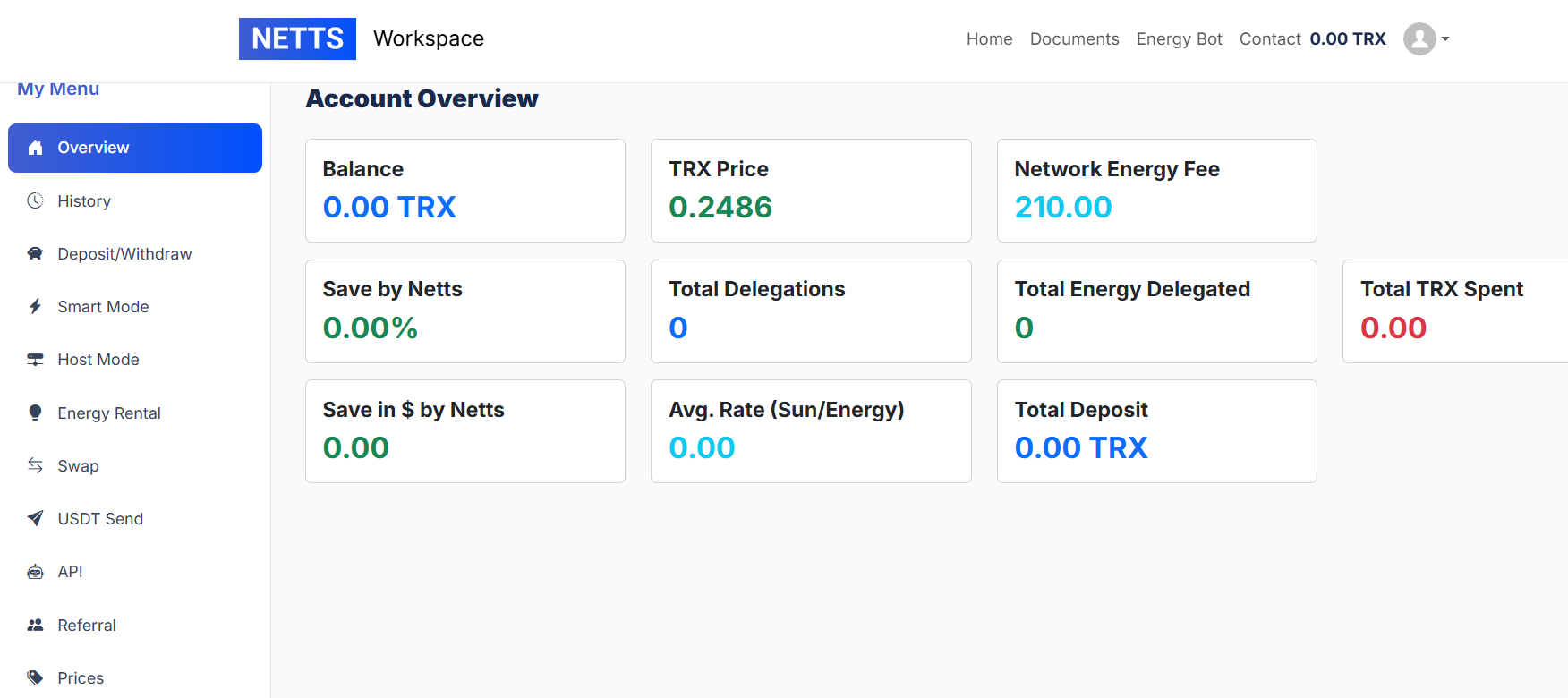
The NETTS Energy rental service has already gained recognition in the Tron community, offering flexible rental options, fee optimization, and incredible savings. Bonus from the service: during periods of minimal network load, the client's deposit is charged only for the Energy actually used by them.
Test the capabilities of the NETTS service right now – simply make a deposit on Workspace (from just 1 TRX). By the way, it can be withdrawn back at any time.
3. TronSave

Website: https://tronsave.io/market
Wallet: https://savewallet.io/
TronSave — a platform built on the TRON Stake 2.0 mechanism, aimed at reducing transaction costs in the Tron ecosystem, as well as providing secure and reliable tools for working with Energy. The project has established itself through active participation in the Tron Hackathon: it ranked in the top three in Season 4 and won 1st place in the Builder category in Season 5, confirming the high quality and reliability of its solutions.
Main advantages for users:
- savings on transaction fees in the Tron network thanks to advantageous Energy rental;
- simplicity and convenience: Energy rental is available for both individuals and projects, with an intuitive interface;
- earn income on unused Energy: users who freeze TRX can receive additional income by renting out unused Energy;
Main advantages for Energy providers:
- up to 25% APY on frozen TRX through providing Energy rental via TronSave;
- stable passive income: you continue to receive staking rewards while renting out Energy to optimize profits;
- flexibility and reliability: you retain full control over frozen TRX, using their Energy to generate additional income.
Additional tools:
- Bulk sender (SaveSender): a service for mass distribution of tokens among a large number of users — fast, convenient, and with optimized fees;
- Swap: an integrated exchange tool with SunSwap, allowing the exchange of various crypto assets in a few clicks;
- SaveWallet (savewallet.io): a crypto wallet developed for the Tron ecosystem that reduces network fees and supports DApps. The project also offers a convenient built-in exchange for quick token conversion.
Thus, TronSave not only significantly reduces transaction costs but also allows earning additional income on frozen TRX. Users receive a high level of security and convenience, and the built-in tools (bulk sender, swap, SaveWallet) make interaction with the Tron ecosystem even simpler and more economical.
4. JustLend DAO

Website: https://app.justlend.org
One of the first DeFi platforms in the Tron ecosystem where you can supply and borrow assets, including crypto resources.
Automated lending platform: orders are matched automatically, without manual negotiation of rates.
Energy rental is one of the "side" functions, where prices depend on market conditions, and you can specify the desired rental period.
TRX is used as collateral, which is returned upon return of the rented Energy.
Although JustLend DAO is primarily focused on lending digital assets, it can also be used for renting Energy, although its interface may seem less convenient compared to specialized services.
5. Tron Energy Market (TEM)
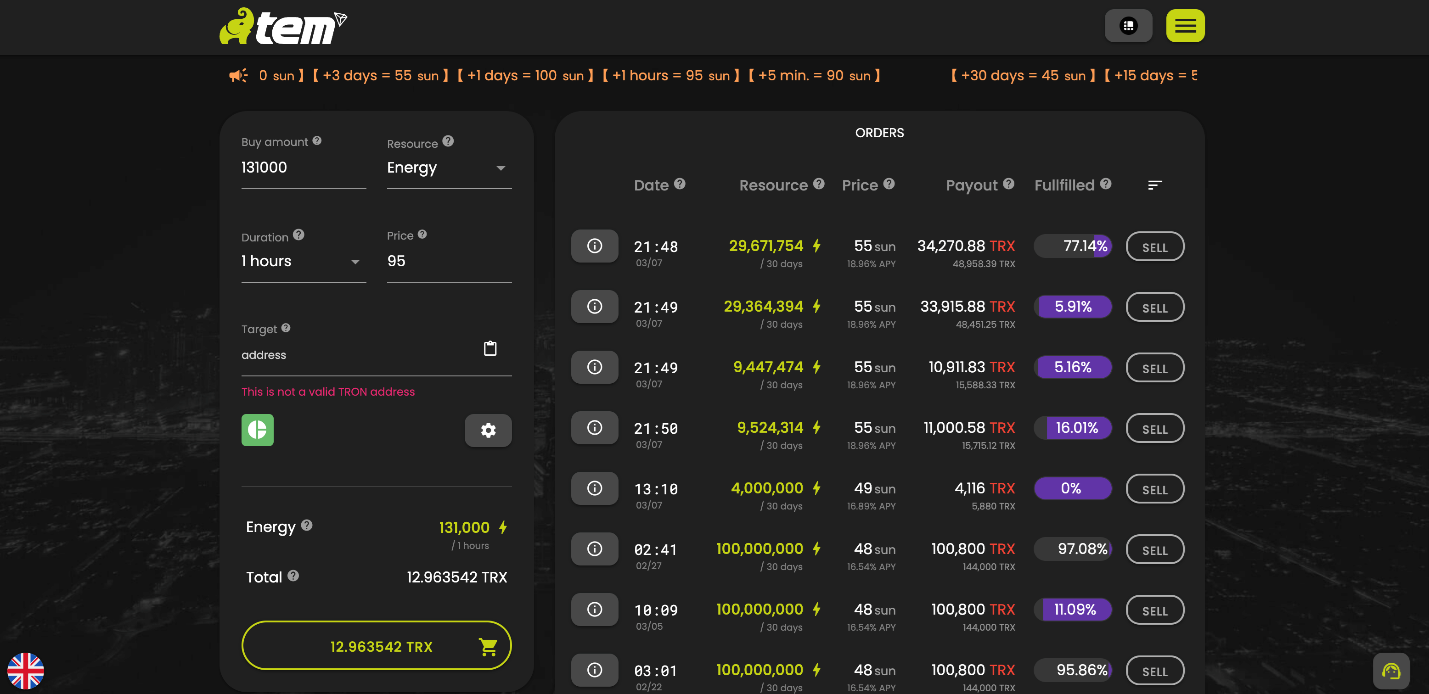
Website: https://tronenergy.market
The goal of TEM is to simplify the automatic purchase, sale, and rental of Energy. Main features:
- Pool system: orders to buy or sell Energy are processed instantly, without long waiting times;
- Direct rewards in TRX for sellers: payments are made directly in TRX, without the use of secondary tokens or delays in payouts;
- Buyers are guaranteed that prices will not dynamically increase depending on the volume.
6. Tron Pulse
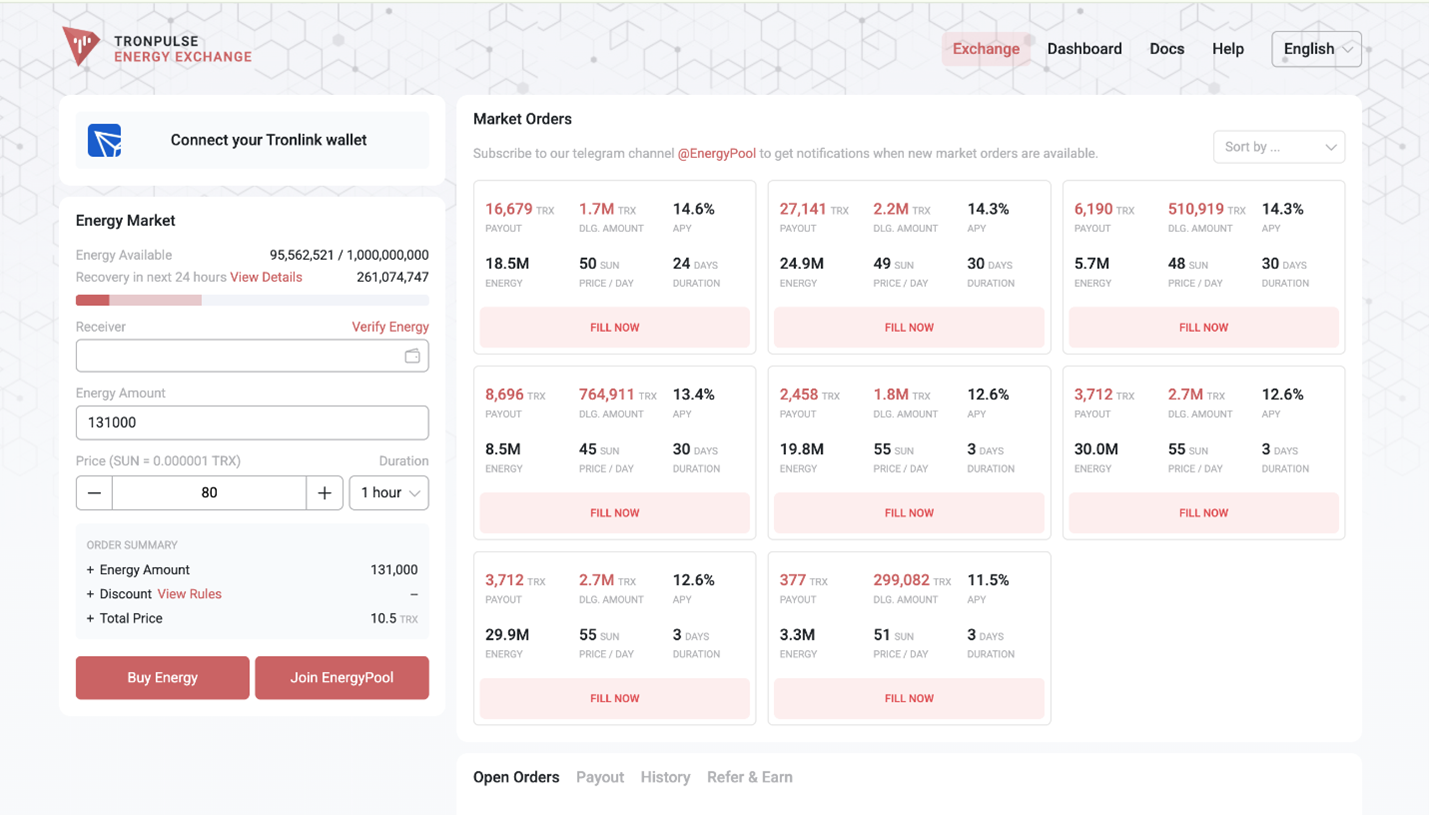
Website: https://tronpulse.io
A P2P platform where users can directly buy and sell Energy.
- Peer-to-Peer model: users place their own orders, and the platform connects buyers and sellers.
- User-friendly interface: dashboard with analytics and detailed transaction information.
- Integration with TronLink: absence of custodial risks — you manage your resources directly from your wallet.
Tron Pulse is aimed at users who prefer direct trading of resources with other participants.
7. Tron Energize
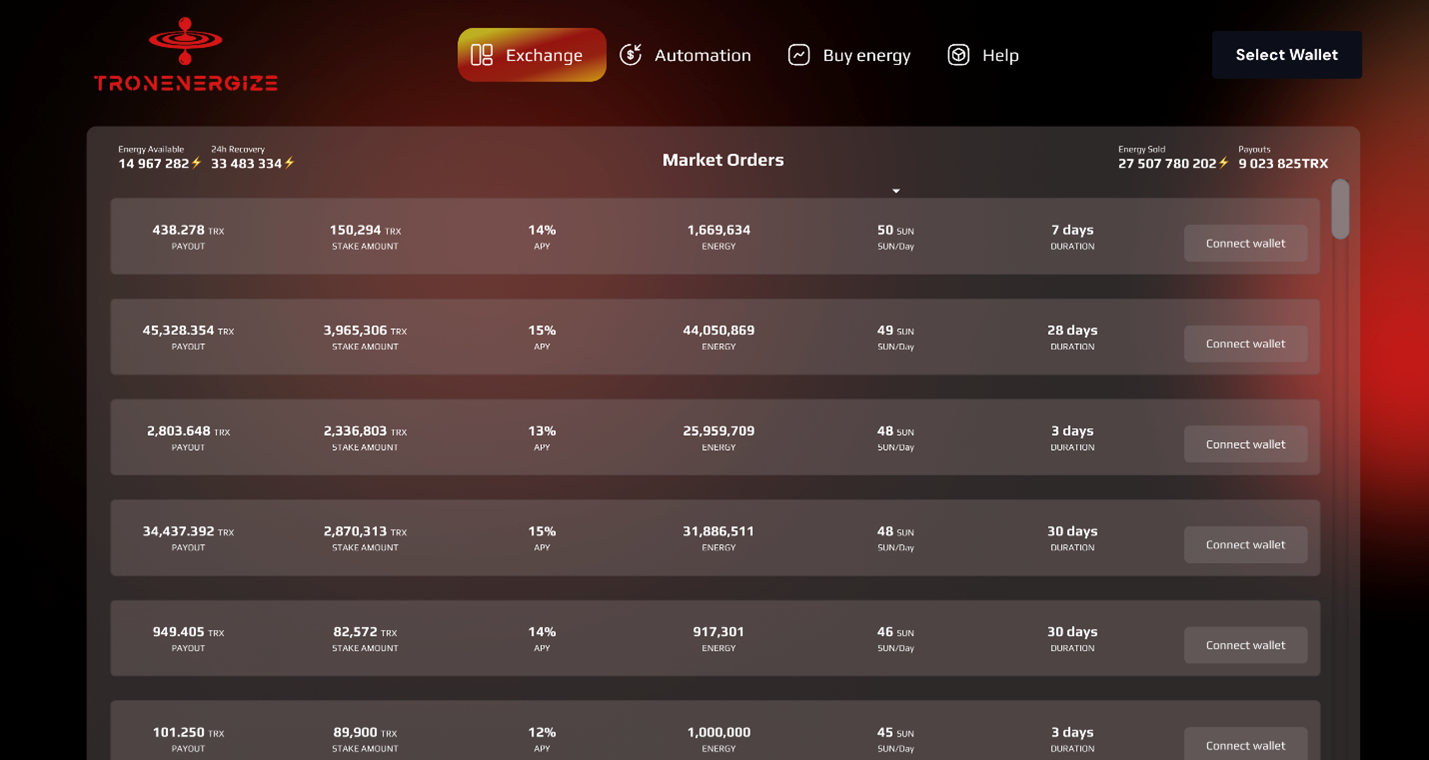
Website: https://tronenergize.com
A project focused on innovation in Energy rental:
- P2P platform for direct access to and exchange of Energy resources;
- Automation — distribution of Energy through smart contracts and decentralized infrastructure;
- Transparency — all actions are recorded on the blockchain.
Initially created to simplify and reduce the cost of renting Energy for active users in the Tron ecosystem.
8. Tron Energy
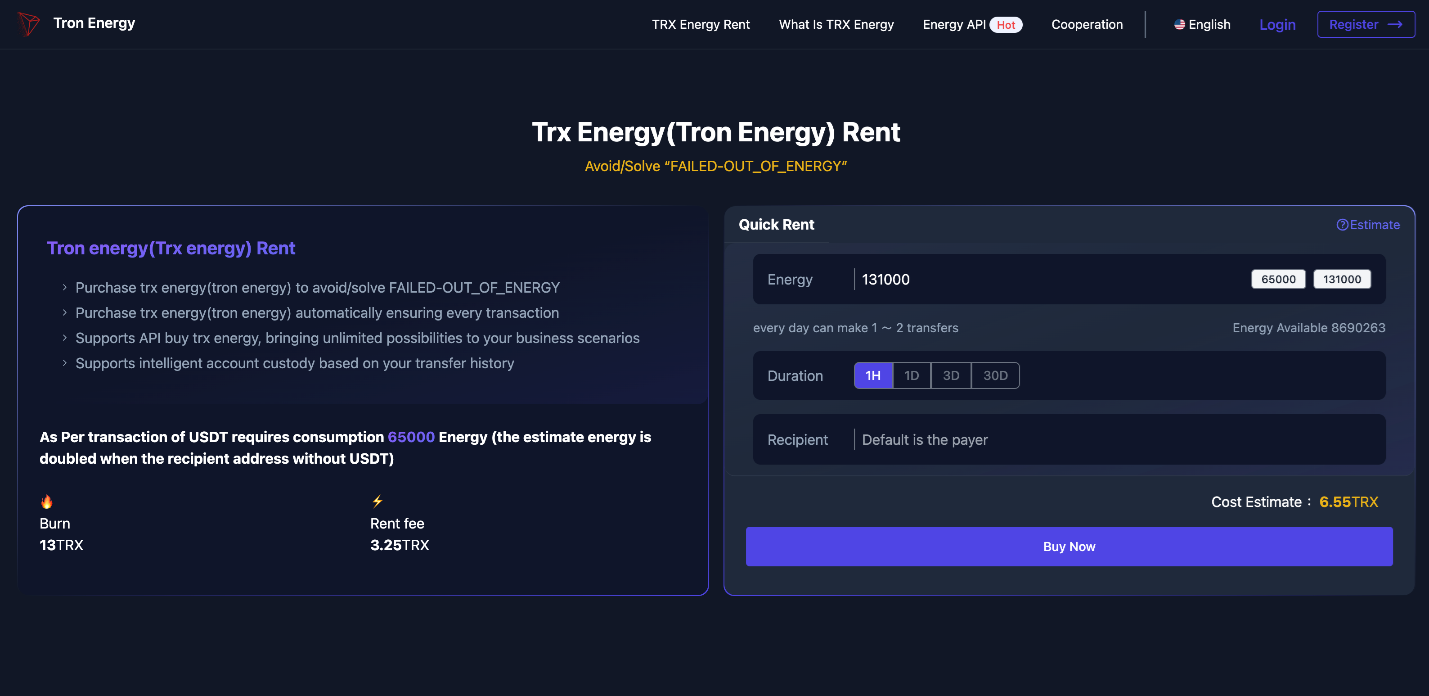
Website: https://itrx.io
A service allowing users to choose a convenient format for renting Energy.
- Flexible minimum rental, starting from 32,000 units of Energy.
- Hourly or daily rental — advantageous if you need Energy for a short period.
- Various ordering methods: manual, bulk, via API, or smart managed order (based on transaction history).
- Low entry threshold and no fees for each small contract.
9. Tron Fee Energy Rental

Website: https://tofee.net
TRON Energy rental service with the following features:
- Save up to 60% on rental fees;
- High transfer speed — transactions are processed in seconds;
- Potential for additional earnings: users can rent out their Energy and receive commissions;
- Supports payments in TRX or USDT, as well as manual and automated (via API) modes.
10. Mefree.net
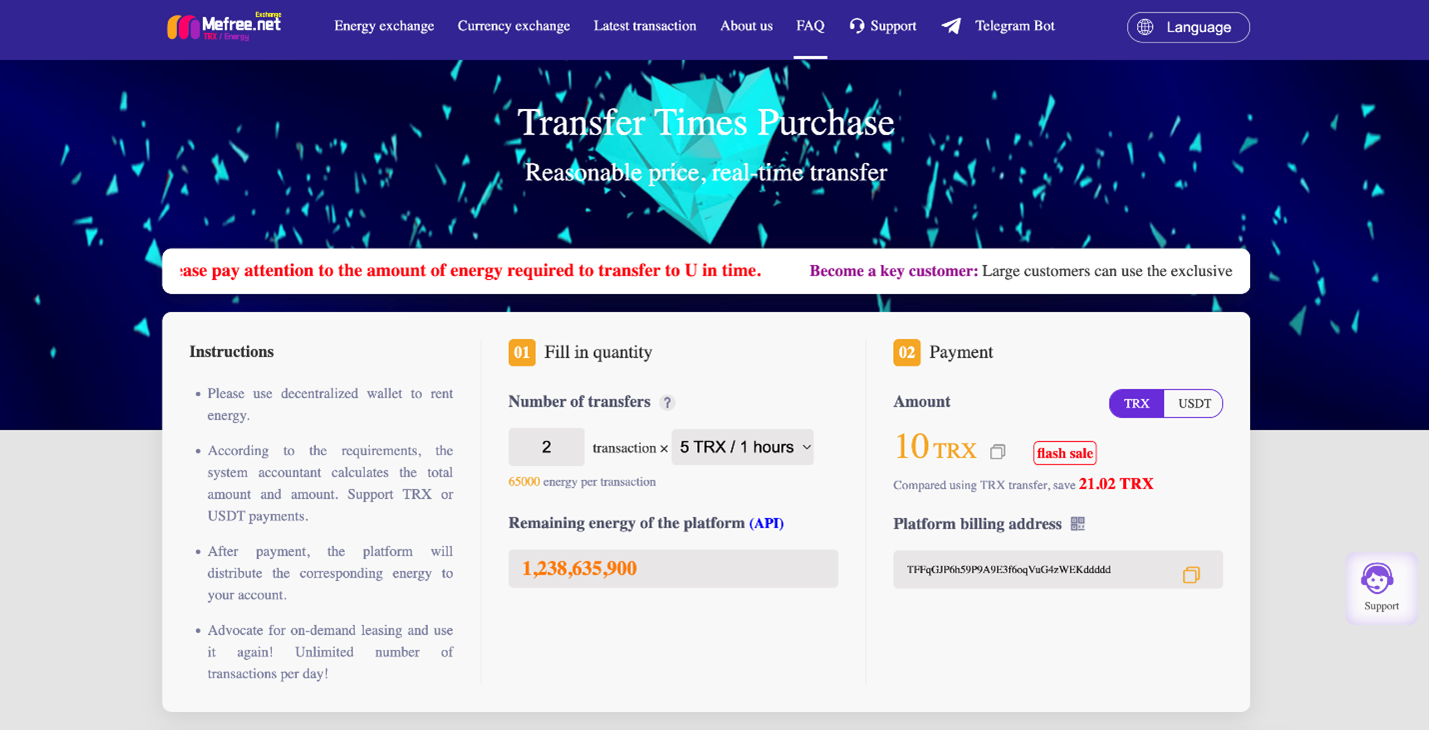
Website: https://mefree.net
Developers position this platform as the "leading provider" of Tron Energy.
- Oriented towards individual users, DApp developers, and businesses.
- API integration for automatic Energy rental in applications.
- Secure transactions, ensured by encryption.
Mefree.net aims to make its services accessible and effective for various categories of clients.
11. Tron Lending
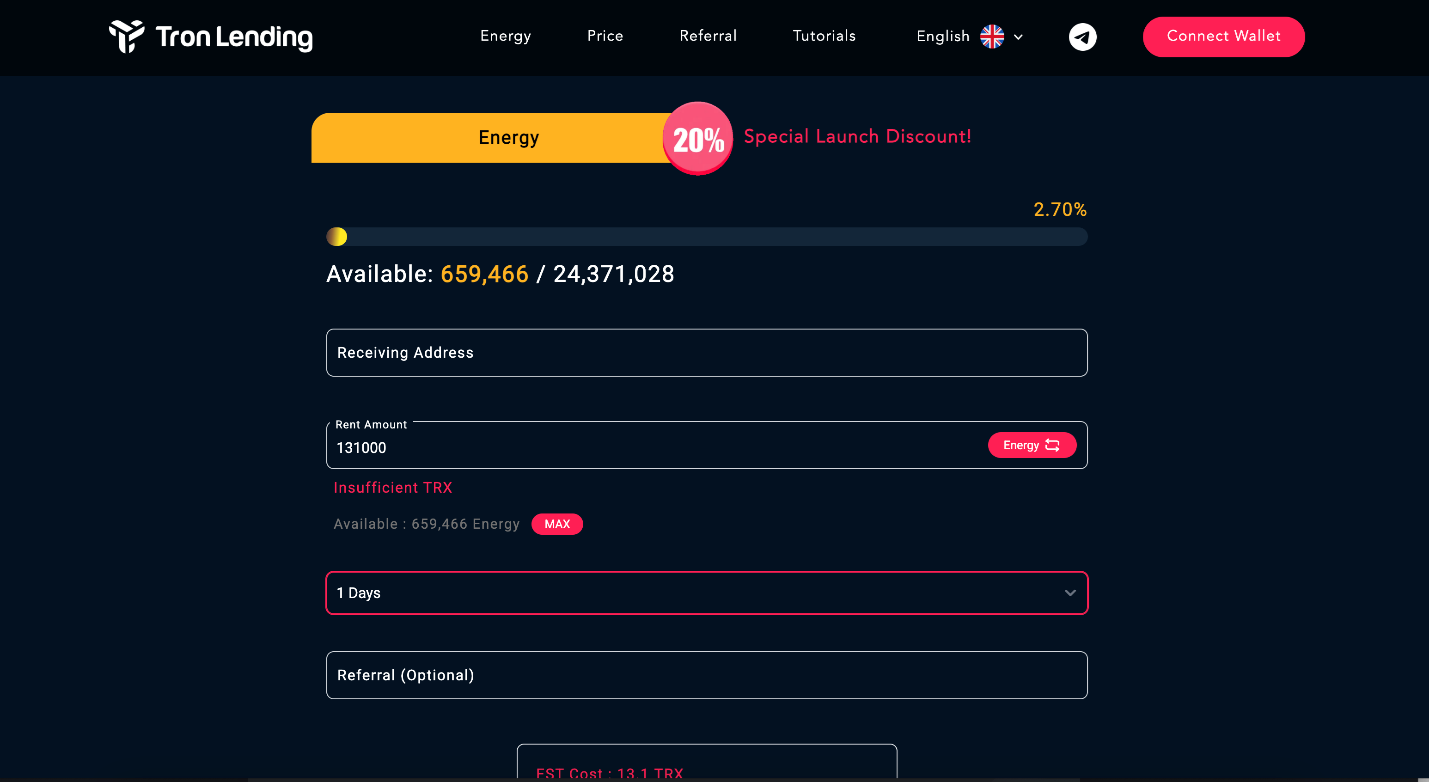
Website: https://tronlending.xyz
A self-service platform for Energy lending and resource trading that:
- reduces the cost of Energy consumption;
- actively supports DApp projects lacking Energy;
- provides a comprehensive set of tools for managing Energy loans, collateral, returns, etc.
Additional Solutions
- DApp Egon. Simplifies access to Tron Stake 2.0, including Energy rental and saving on transaction fees.
- Brutus Energy Bot. A Telegram bot that automates the rental and transfer of Tron resources.
- com (API). A specialized "Tron Energy market" where no user interface is required.
Conclusion
Renting Tron Energy is a convenient way to reduce fees when transferring USDT and using smart contracts on the Tron network without burning your own TRX or freezing large amounts. Thanks to numerous services, users can choose the option that best suits their needs based on cost, rental period, interface, and additional features:
- save up to 80% by eliminating TRX fees for each operation;
- avoid freezing large amounts, which allows maintaining liquidity;
- rent Energy for a period from one hour to one month and perform the required number of transactions without fees in TRX;
- ability to set your own mode for replenishing the Energy balance.
Choose the service that best meets your requirements (level of automation, rental period, payment mechanism) and enjoy using the Tron network with minimal costs. We hope this review helps you make the right choice and significantly save on transaction fees.